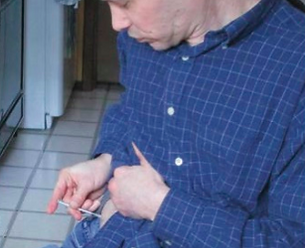The Evolution of Diabetes Treatment:
Bringing Users' Voices to Inform New Device Designs

Contextual Research with Patients and Health Care Providers to Identify Need-Based Opportunities for Treatment Innovation
The Project
Our client manufactures drug delivery devices which are used for a variety of medications/ brands, including insulin. They want to offer innovative, meaningful device designs to their pharma clients. To inform their own development work and strategy, they commissioned a user research project. What do users currently have, need, and want in the field of diabetes treatment?



The Research Approach
Contextual Observation: We conducted in-context interviews with a diverse mix of diabetic individuals ranging in age, experience, and treatment (pen/ pump/ syringe). We wanted to understand their holistic experience with diabetes, so the interviews covered a range of topics: diabetes onset, trajectory, current treatment, treatment/ device choices and drivers, goals, and challenges, and the emotional experience throughout.
By conducting the interviews in participants' homes, we could learn about their treatment in the context of their everyday lives. We asked participants to guide us on a narrative tour of the spaces and activities in the home that have been impacted by diabetes. We also asked to observe a (real or simulated) injection. This allowed us to learn the workflow, understand the user experience, and observe the benefits and challenges associated with a wide range of current devices.
Visual Stimuli & Activities: To understand motivations and emotions around diabetes treatment, we incorporated visual stimuli to help prompt discussions. For instance, we asked participants to describe which image best represented their relationship to their diabetes treatment device. We also asked participants to write an advice letter to a friend who had recently been diagnosed with diabetes, explaining what they might be feeling, how the situation evolves and what they might expect, and sharing what they've learned around how to live with, and managing, diabetes.
In-depth Interviews: We conducted in-depth interviews with health care providers including GPs, diabetes nurse educators, and endocrinologists. In these sessions we discussed their approach to diabetes management, drivers for treatment modalities and devices, patient struggles, goals and challenges, trends in the field, and treatment ideals.
As Research Lead, I designed the protocol, managed the recruit of appropriate sites and participants, and led data collection and analysis.
Analysis & Synthesis
The team worked through the data to systematically code themes as well as brainstorm around observations and opportunities. For example, we mapped the injection workflow at a granular level, depicting a day in the life of a diabetic user with detailed challenges and workarounds. We also explored treatment preferences and emotional reactions to insulin delivery devices (pen/ pump/ syringe) by user experience level, which led to one of our most utilized frameworks: The Patient Journey. We found a consistent trajectory in patients' emotional journeys over time, which had direct implications on their treatment adherence and device preferences. We told this story with a poster, slides, and videos.
We identified a large set of opportunity areas to discuss that would solve for unmet user needs, improve the user experience, and provide differentiation from current market offerings. As an example, the Patient Journey inspired the opportunity to provide device options that were customized to the user's experience level, providing just the amount of guidance, control, and transparency desired in the injection process.




Presentation & Workshop
We presented the research findings and opportunities to cross functional team members and executives. We then designed and conducted an interactive, all-day strategy workshop in which we collaboratively evaluated and ideated on the different opportunities. By the end of the day, the team had identified a subset of opportunities that were aligned with near term and long term goals, and had brainstormed a number of concept directions and "next steps" to pursue.
The Impact
The client pursued a number of opportunities identified, which productively informed existing development projects and inspired new efforts and investigations (ongoing). They also credited the project with enabling many generative conversations with their business partners, as it allowed them to present knowledgeable, innovative ideas around improving the user experience that differentiated their portfolio and brand. They've also adopted the longitudinal Patient Journey framework to explore other disease states, and inspire continued innovation and user-centered design.